In the early 1990s, a small number of photos signed “Arzapalo” were included in J. Jesús González Gortázar’s book Aquellos tiempos en Chapala. Judging by their subject matter, the Arzapalo who took these photographs was almost certainly Ignacio Arzapalo Palacios (1837-1909), though there is a small possibility that they were the work of his son, José Ignacio Arzapalo Pacheco (1878-1904).
Ignacio Arzapalo was the man who built the Hotel Arzapalo, Chapala’s first purpose-built hotel which opened with 36 large and comfortable rooms in 1898. For the record, brief biographies of Arzapalo appear in each of my previous books about the Chapala area – Western Mexico, A Traveler’s Treasury and Lake Chapala Through the Ages – but I now realize that my descriptions of his life were not entirely accurate.

Ignacio Arzapalo. ca. 1898. San Francisco Church, Chapala. [from Aquellos tiempos en Chapala)
Ignacio Arzapalo was born in the mining town of Cosalá, Sinaloa, in 1837. He had two marriages, the first of which was to Emilia Salgado Maldonado. They married in Mazatlán on 12 February 1963 and their daughter Delfina was born in 1865. Two years later Emilia bore him twin girls: Emilia and María Luisa. Emilia, Arzapalo’s first wife, died in 1875.
By the 1870s, Arzapalo was living in Guadalajara, apparently without his daughters. In 1877 he married 16-year-old María Pacheco in that city; their son, José Ignacio, was born the following year on 7 February 1878. José Ignacio, who was sent to school in Denver, eventually married into the highest levels of Guadalajara society, taking as his bride Aurora Pérez Verdía, the daughter of influential lawyer and historian Luis Pérez Verdía and his wife. José Ignacio died in Guadalajara in 1904; his father Ignacio Arzapalo died in Guadalajara five years later, on 6 May 1909.

Ignacio Arzapalo. ca. 1898. Chapala shoreline. [from Aquellos tiempos en Chapala)
In 1888 Arzapalo was elected to a seat on the Guadalajara city council.
Coincidentally, only a couple of months earlier, his wife had lent her diamond necklace to a group of people interested in witnessing the skills of American mentalist Washington Irving Bishop who was visiting the city. The necklace was hidden, without his knowledge, a mile away from the Hotel Humboldt where he was staying. Wearing a blindfold, he was walked out of the hotel and placed in a carriage. The instructions he relayed to the driver took the carriage directly to the necklace to the cheers and applause of thousands of onlookers.

Ignacio Arzapalo. ca. 1898. Villa Capetillo, Chapala. [from Aquellos tiempos en Chapala)
As plans progressed, he continued to do his civic duty in Guadalajara, sitting on the board of the “Círculo Mercantil” and as a member of the group planning the city’s Parque Agua Azul.
Construction of his two-story hotel in Chapala got underway in earnest in 1896 and the hotel opened for business in 1898.
Even if we don’t know who the architect of the Hotel Arzapalo was, we do know that Arzapalo commissioned Guillermo de Alba when he decided to build a second, even better-appointed hotel. The Hotel Palmera had its formal opening in 1908. Part of the original Arzapalo Hotel is now the lakefront Beer Garden restaurant-bar. The Hotel Palmera later became two hotels: Hotel Nido (now Chapala’s Presidencia Municipal or city hall) and the short-lived Hotel Niza.
Not surprisingly, given his obvious commercial interests, Ignacio Arzapalo was an active member of the Jalisco Development Company which proposed, in 1902, building an electric railroad from Guadalajara to Chapala, and was one of the business leaders trying, in 1904, to form the first Chapala Yacht Club. Though neither of those projects came to fruition, Arzapalo’s contributions to Chapala were one of the crucial steps in transforming the former fishing village into Mexico’s premier lakeside resort.
Note
While aware that the quality of these images is not up to our usual standards, we believe they are worth reproducing. If any reader has access to better quality images of photographs by Ignacio Arzapalo please get in touch!
This profile was updated, with minor corrections and additions, in September 2022.
Sources
- Anales del Ministerio de Fomento de la República Mexicana, Volume 4, 1881.
- El Siglo Diez y Nueve, 16 Jan 1892.
- El Tiempo, 28 June 1893; 11 Sep 1896.
- Jalisco Times, 27 Aug 1904.
- J. Jesús González Gortázar. 1992. Aquellos tiempos en Chapala. Guadalajara: Editorial Agata.
- La Patria, 12 August 1904, 2.
- La Voz de México, 27 Sep 1888.
Comments, corrections or additional material related to any of the writers and artists featured in our series of mini-bios are welcomed. Please use the comments feature at the bottom of individual posts, or email us.
Tony Burton’s books include “Lake Chapala: A Postcard History” (2022), “Foreign Footprints in Ajijic” (2022), “If Walls Could Talk: Chapala’s historic buildings and their former occupants” (2020), (available in translation as “Si Las Paredes Hablaran”), “Mexican Kaleidoscope” (2016), and “Lake Chapala Through the Ages” (2008).